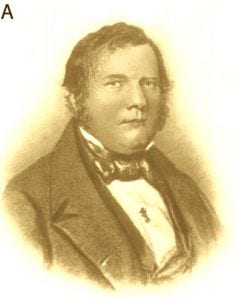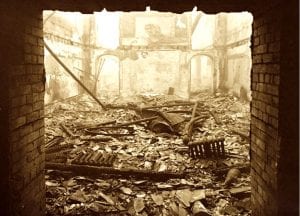The first bones are found
The Bristol dinosaur first came to light in 1834, when quarrymen found bones in a series of quarries in Clifton, Bristol, along the north side of Worrall Road. In the 1830s, there were several deep quarries for building stone, and they were driven northwards from the level of Worrall Road towards the Downs, which stood much higher. This created a high south-facing active quarry wall. Indeed, quarrying had to stop about 1840 because the north and east faces of the quarries were beginning to undermine houses built on top.
The quarrymen took their mystery bones to Samuel Stutchbury, who was the curator of the museum of the Bristol Institution for the Advancement of Science, Literature and the Arts. This private society had been founded in 1823, and its meeting rooms and museum were housed in a grand building at the foot of Park Street, which is now the home of Bristol’s freemasons. Stutchbury recognised the importance of these bones, and he called on Henry Riley, a renowned local surgeon, who was able to provide the anatomical expertise to interpret the bones.
But at that time, nobody knew what dinosaurs were – in fact, the word ‘dinosaur’ was only invented eight years later, in 1842. What we now call dinosaurs had been found, but they were called ‘giant lizards’. The first to be named was Megalosaurus, in 1824, then Iguanodon in 1825, and Hylaeosaurus in 1832. So, three dinosaurs had been named by 1834, and which would be the fourth?
Riley and Stutchbury
 Samuel Stutchbury (1798-1859) [left] began his professional career as an assistant at the Hunterian Museum of the Royal College of Surgeons in London, and he made an adventurous collecting trip to the Pacific and became an expert on the corals and shells he encountered. Stutchbury was then hired as curator of the Bristol Institution in 1831, and served there until 1850 when he left, probably because museum funds were running out and his salary had barely advanced. He went to Australia as mineral surveyor for New South Wales, but returned to Bristol and died in 1859, the year of Darwin’s Origin of Species. He is buried in Bristol’s Arnos Vale Cemetery.
Samuel Stutchbury (1798-1859) [left] began his professional career as an assistant at the Hunterian Museum of the Royal College of Surgeons in London, and he made an adventurous collecting trip to the Pacific and became an expert on the corals and shells he encountered. Stutchbury was then hired as curator of the Bristol Institution in 1831, and served there until 1850 when he left, probably because museum funds were running out and his salary had barely advanced. He went to Australia as mineral surveyor for New South Wales, but returned to Bristol and died in 1859, the year of Darwin’s Origin of Species. He is buried in Bristol’s Arnos Vale Cemetery.
 Henry Riley (1797-1848) [right] was a local surgeon and medical teacher who had been trained in Paris. He gave a successful series of lectures in Bristol, emphasising the works of the fashionable French anatomists, Lamarck, Cuvier, and Geoffroy, and he was a member of the important group of gentleman naturalists who founded the Bristol Institution in the 1820s. Riley was involved in a body snatching scandal in the late 1820s, and was renowned for his yellow waistcoats, worn in the daring Parisian fashion.
Henry Riley (1797-1848) [right] was a local surgeon and medical teacher who had been trained in Paris. He gave a successful series of lectures in Bristol, emphasising the works of the fashionable French anatomists, Lamarck, Cuvier, and Geoffroy, and he was a member of the important group of gentleman naturalists who founded the Bristol Institution in the 1820s. Riley was involved in a body snatching scandal in the late 1820s, and was renowned for his yellow waistcoats, worn in the daring Parisian fashion.
The gentleman surgeon and naturalist Dr. Riley, and the paid curator Mr. Stutchbury, read a paper about the new reptile finds to the Geological Society of London in March, 1836, and to the British Association for the Advancement of Science, which met in Bristol later that year. Their 1836 paper is not illustrated, but it gives a full-page of description of the new animal, which they named as Thecodontosaurus, and it indicates that the bones are in the Museum of the Bristol Institution. This means it counts as the paper that formally named the Bristol dinosaur. So, the Bristol dinosaur Thecodontosaurus was the fourth dinosaur ever named from anywhere in the world.
Studying the Bristol dinosaur
Riley and Stutchbury continued working on the Bristol bones, and eventually published a full account of the animal in the Transactions of the Geological Society of London. This was a tricky task at that time, and costly. One or other of the gentlemen had to go to London (no trains then) to present their paper to the Geological Society. They wanted to illustrate the bones, and this was a large task also – there were no cameras or photographs then. The bones had to be drawn by an artist, and then they were engraved for printing; Riley and Stutchbury had to pay for all this. So, it wasn’t easy – or cheap – to be a scientist then!
When Sir Richard Owen named the Dinosauria in 1842, he included Megalosaurus, Iguanodon, and Hylaeosaurus, but not Thecodontosaurus – he classed it as an ‘inferior or squamate saurian’, with some resemblances to crocodiles, lizards, and dinosaurs. It was only in 1870 that Thomas Huxley finally recognized that Thecodontosaurus was a dinosaur, and so it has been recognized ever since.
What none of the Victorian palaeontologists had done was to provide a full description of the Thecodontosaurus material. This was rectified by the enthusiastic German palaeontologist Friedrich von Huene, who described and illustrated the entire Thecodontosaurus collection from the 1840s, some 300-400 bones in publications in 1902, 1908, and 1914.
Catastrophe
 Bristol City Museum was bombed in 1940, and nearly everything on show was destroyed, including all the best Thecodontosaurus bones. Other important specimens were lost, including the priceless collection of marine reptiles purchased in the 1820s and 1830s from Mary Anning of Lyme Regis. The roof of the Museum fell in, and everything was burned (see right)
Bristol City Museum was bombed in 1940, and nearly everything on show was destroyed, including all the best Thecodontosaurus bones. Other important specimens were lost, including the priceless collection of marine reptiles purchased in the 1820s and 1830s from Mary Anning of Lyme Regis. The roof of the Museum fell in, and everything was burned (see right)
It had then been assumed that essentially everything was lost, but in fact the bulk of the non-exhibit collections of fossils had been stored in an old railway tunnel in Avon Gorge, and these were retrieved after the war, including 184 specimens of Thecodontosaurus. Together with specimens in other museums, 245 specimens of the 1830s collection remain.
After the War
These Thecodontosaurus specimens were brought back to the Museum after the War, and they were unpacked in the late 1950s. They were studied by various palaeontologists in the 1950s and 1960s, but nothing was written until 2000, when a complete review of everything was published by Mike Benton and colleagues at Bristol University. In this paper, a careful reconstruction of Thecodontosaurus was made (see below) by renowned palaeo-artist, John Sibbick.
 Currently, there is a display case with some Thecodontosaurus specimens in Bristol City Museum, including one remarkable specimen that shows smoke damage from the bombing of 1940. An associated diorama shows a full-sized model of Thecodontosaurus in life, together with the small lizard-like Diphydontosaurus and appropriate Late Triassic plants, constructed by local sculptor Arril Johnson about 1990. Also, the ‘M Shed’ museum at Bristol docks includes a permanent case dedicated to Thecodontosaurus and exhibiting some of the original specimens.
Currently, there is a display case with some Thecodontosaurus specimens in Bristol City Museum, including one remarkable specimen that shows smoke damage from the bombing of 1940. An associated diorama shows a full-sized model of Thecodontosaurus in life, together with the small lizard-like Diphydontosaurus and appropriate Late Triassic plants, constructed by local sculptor Arril Johnson about 1990. Also, the ‘M Shed’ museum at Bristol docks includes a permanent case dedicated to Thecodontosaurus and exhibiting some of the original specimens.
Research on Thecodontosaurus continues at the University of Bristol, where doctoral student Antonio Bayell Mayoral began his Phd in 2018 to study the mechanics of its locomotion.
Read more
- Brian Switek’s article for the Smithsonian Museum, Tussling over Thecodontosaurus
- Benton, M.J. 2012. Naming the Bristol dinosaur, Thecodontosaurus: politics and science in the 1830s. Proceedings of the Geologists’ Association 123, 766-778. pdf.
- Benton, M.J., L. Juul, G. W. Storrs, and P. M. Galton 2000. Anatomy and systematics of the prosauropod dinosaur Thecodontosaurus antiquus from the Upper Triassic of southwest England. Journal of Vertebrate Palaeontology 20, 77-108. pdf

